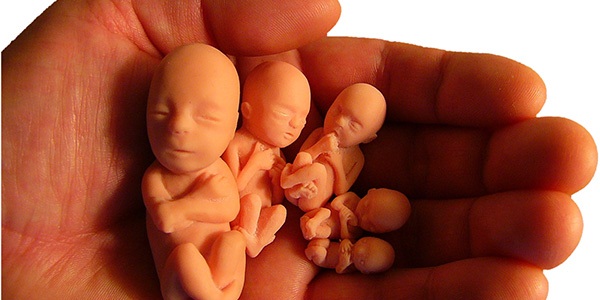An article posted on The Abortioneers [see the cached page here while you can], a pro-choice blog, is an interesting, inside look at the inner conflict often experienced by second trimester abortion providers, who use “large forceps with destructive teeth to remove the fetus, generally in parts.”
Since many abortion providers undergo “serious emotional reactions” after aborting a second trimester fetus and thereafter choose to limit their own services to the first trimester, the author of the article, Lisa Harris, is trying to promote more open discussion by providers about the “physiological symptoms, sleep disturbances (including disturbing dreams), effects on interpersonal relationships and moral anguish” that they experience. Her hope is that when these reactions are squarely faced, a way of viewing them and dealing with them will be developed that will make it easier for abortion providers to continue with their work, creating a stronger pro-choice movement.
Harris describes her own experience when aborting an 18-week-old fetus while she was also 18 weeks pregnant:
As I reviewed her chart I realised that I was more interested than usual in seeing the fetal parts when I was done, since they would so closely resemble those of my own fetus. I went about doing the procedure as usual.... I used electrical suction to remove the amniotic fluid, picked up my forceps and began to remove the fetus in parts, as I always did. I felt lucky that this one was already in the breech position – it would make grasping small parts (legs and arms) a little easier. With my first pass of the forceps, I grasped an extremity and began to pull it down. I could see a small foot hanging from the teeth of my forceps. With a quick tug, I separated the leg. Precisely at that moment, I felt a kick – a fluttery “thump, thump” in my own uterus. It was one of the first times I felt fetal movement. There was a leg and foot in my forceps, and a “thump, thump” in my abdomen. Instantly, tears were streaming from my eyes – without me – meaning my conscious brain - even being aware of what was going on. I felt as if my response had come entirely from my body, bypassing my usual cognitive processing completely. A message seemed to travel from my hand and my uterus to my tear ducts. It was an overwhelming feeling – a brutally visceral response – heartfelt and unmediated by my training or my feminist pro-choice politics. It was one of the more raw moments in my life.
Harris acknowledges that while the moral status of a fetus is under debate, “it is disingenuous to argue that removing a fetus from a uterus is no different from removing a fibroid.” She also fully recognizes the strangely contradictory approaches doctors take toward fetuses of the exact same age:
As a third-year resident I spent many days in our hospital abortion clinic. The last patient I saw one day was 23 weeks pregnant. I performed an uncomplicated D&E procedure. Dutifully, I went through the task of reassembling the fetal parts in the metal tray. It is an odd ritual that abortion providers perform – required as a clinical safety measure to ensure that nothing is left behind in the uterus to cause a complication – but it also permits us in an odd way to pay respect to the fetus (feelings of awe are not uncommon when looking at miniature fingers and fingernails, heart, intestines, kidneys, adrenal glands), even as we simultaneously have complete disregard for it. Then I rushed upstairs to take overnight call on labour and delivery. The first patient that came in was prematurely delivering at 23–24 weeks. As her exact gestational age was in question, the neonatal intensive care unit (NICU) team resuscitated the premature newborn and brought it to the NICU. Later, along with the distraught parents, I watched the neonate on the ventilator. I thought to myself how bizarre it was that I could have legally dismembered this fetus-now-newborn if it were inside its mother’s uterus – but that the same kind of violence against it now would be illegal, and unspeakable.
Harris distrusts her intuitive reaction to not only the abortions, but to the contradictions, and she goes on to remind us that though it struck her at the moment as bizarre, the reality was that the “difference between the [two fetuses] was, crucially, its location inside or outside of the woman’s body, and most importantly, her hopes and wishes for that fetus/baby.”
It is utterly amazing to me that a person could see some of these things so clearly, could be informed so strongly by her own moral intuition, could grasp the contradictions, and yet could have a response that seeks to find a way to overcome the “visual and visceral ways in which first and second trimester abortions are different,” rather than to reflect logically on what these things might mean and ask the question, How on earth could one person’s “hopes and wishes” magically transform “unspeakable violence” against another person into something acceptable that one ought to work hard to encourage?
The human ability to reshape the conscience through argument, even in the face of such dramatic, “visceral” reactions to the contrary should give us pause. My guess is that unless you have carefully trained yourself otherwise, merely reading the descriptions above was sickening. But what if you, like the author, were wrongly convinced that something far more morally significant was at stake--something that you believed would suffer if you gave in to your moral intuitions and rational questioning of contradictions? And further, what if the pressures of your respected colleagues and the culture consistently spoke against your own conscience? Could you not also be capable of convincing yourself of anything?
On our own we are lost, at the mercy of our greatest desires and false beliefs, swayed (often unknowingly) into improperly ordering competing moral goods in a way that best advantages our own interests. But, “The fear of the Lord is the beginning of knowledge.” Lisa Harris’s story should remind us of our desperate need for God to properly inform and shape our consciences as we purposefully and consistently seek a more thorough knowledge of His character, power, and Word, immersing ourselves in His wisdom.
[UPDATE: The post has been removed from The Abortioneers. Information about the article by Lisa Harris, “Second Trimester Abortion Provision: Breaking the Silence and Changing the Discourse,” can be found here.]

